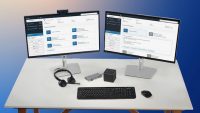Amazon Thin Client Connects Employees to Virtual Desktops
November 29, 2023
Amazon’s new Thin Client is a new $195 device that allows enterprise users to connect to virtual desktop environments, such as Amazon WorkSpaces, using the Internet and a box as compact as the Fire TV Cube. In fact, the Thin Client leverages Fire TV Cube hardware, allowing Amazon to tap existing expertise from the e-retail giant’s streaming media player division. However, Thin Client “is not for spending time watching Thursday Night Football, or bingeing ‘Invincible,’” but aims to convenience workers while reducing technology costs and enhancing security for enterprise, the company says.
Thin Client is the result of customer feedback about wanting to reduce the IT costs associated with equipping staff with desktops and laptops with a less expensive alternative.

“A virtual desktop is a workstation hosted in a data center rather than the user’s office,” explains SiliconANGLE, noting that workers “log into the machines remotely over the network,” with many enterprises providing employees with “thin clients” — low-cost computers optimized for cloud-based use — to access the virtual desktops.
“Today, many of Amazon’s enterprise customers log on to virtual desktops based on AWS End User Computing Services, like Amazon WorkSpaces, WorkSpaces Web or Amazon AppStream” using desktops or laptops “that cost their employer $600 to $1,200 each,” TechCrunch reports. The new devices “will dramatically undercut that pricing, though they will not have all the capabilities of a dedicated PC.”
But they will be able to deploy quickly and accomplish most tasks for a lower price, all of which are typically attractive to enterprise employers, Amazon being one of them. “When it came time to design the hardware, Amazon decided not to reinvent the wheel,” TechCrunch reports.
The company created a new software stack for the device, reports ZDNet, explaining “the hardware includes a specific operating system that gives your staff access to Amazon’s cloud-based applications.” But Amazon “didn’t have to build the new hardware, which allowed them to keep costs down,” per TechCrunch.
“Combining the expertise from the Amazon Devices group with logistics from Amazon Business and the power of the AWS Cloud is a strong combination for customers,” said Melissa Stein, director of product management for AWS, in a news release.

No Comments Yet
You can be the first to comment!
Leave a comment
You must be logged in to post a comment.